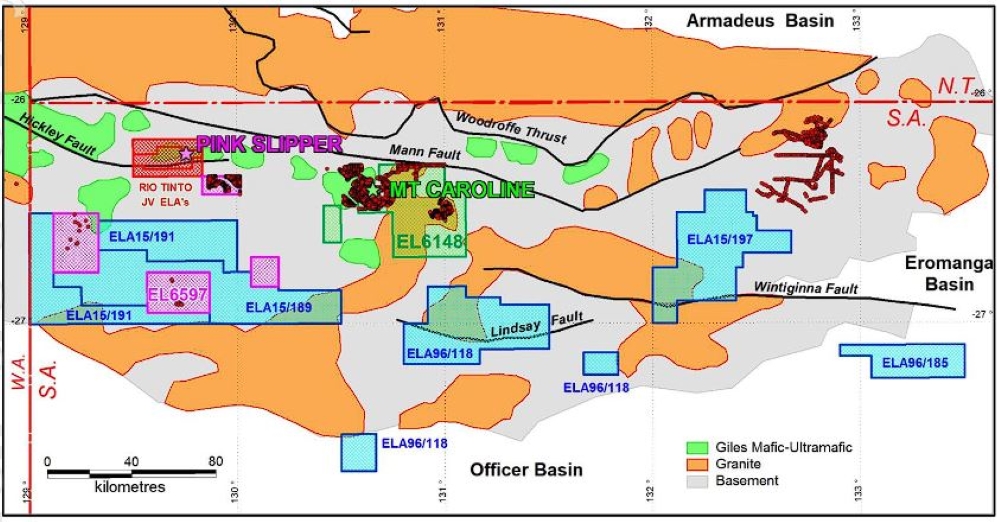Eyes on the critical minerals prize: New nickel-copper-PGE targets identified at Power Minerals’ Musgrave project

Power Minerals is scoping out Mt Caroline, part of its Musgrave critical minerals project. Pic via Getty Images.
- Exploration targets have been defined at Musgrave nickel-copper-PGE project
- Studies by the University of Adelaide and PNN have defined a stratigraphic exploration target within Mt Caroline
- Future exploration will test below the surface cover sequence
Explorer Power Minerals is heading back for more exploration at its Musgrave project in northern South Australia, where it’s delineated copper, nickel and PGE targets at the highly prospective Mt Caroline intrusion.
Recent exploration results in tandem with a University of Adelaide study of Musgrave is rapidly advancing Power Minerals’ (ASX:PNN) understanding of the sulphide-hosting Mt Caroline intrusion, where historical and recent samples assessed the potential for copper, nickel and PGE’s.
Most of the world’s nickel-PGE-chrome deposits lie in mafic and ultramafic-layered complexes as the metals tend to crystallise as magma pulses. This allows for the concentration of discrete layers of the metals where mining operations can economically extract them.
Mt Caroline hits all these markers. PNN says the study presents an exciting target model for future exploration programs and drilling to test below the surface cover sequence for mineralisation.
Mt Caroline
Mt Caroline is nestled in the EL6148 tenement, which includes the highly prospective mafic-ultramafic intrusion.
More than 3,100 pXRF whole-rock analyses have been completed over the past year, “using a full three-beam pXRF multi-element matrix to check and measure historical samples to aid in the generation of drill targets”, PNN says.
An analysis of 423 microprobe of major elements were completed, as well as laser-ablation ICP-MS of trace elements.
PNN saysthe study determined that the Mt Caroline intrusive body is comprised of two distinctive domains, warranting further studies.

Historical background
Power’s historic exploration of the project included drilling at the Mt Caroline intrusion, part of the Giles Complex, intersecting abbronorite, gabbro, troctolite and anorthosite-gabbro rocks.
Back in 2005, PNN completed a 3,567m drilling campaign where the explorer intersected disseminated sulphides that confirmed continuity across the Mt Caroline intrusion.
Disseminated sulphides were intersected in many of these previous drillholes, and drilling confirmed the continuity of sulphide across the Mt Caroline intrusion.
PNN says the presence of primary sulphide within the Mt Caroline intrusion “indicate that the magma had reached sulphur saturation” – a prerequisite for massive sulphide accumulation.
Sulphide proportions ranged from trace amounts to 5-25% and were dominated by pyrrhotite (iron-bearing) with rare chalcopyrite (copper-bearing) and pentlandite (nickel-bearing).
Power Minerals MD Mena Habib said he was excited about the progress at Musgrave.
“We have taken positive strides in confirming our geological understanding of the Musgrave project area – and in unlocking its value,” Habib says.
“The recently completed study is evidence of this and has resulted in the definition of a significant, new stratigraphic exploration target at the priority Mt Caroline intrusion, one of the most prospective intrusions in the Musgrave province.
“We look forward to being in a position to commence on-ground exploration at this key target once heritage surveys and other required approvals have been secured.”
This article was developed in collaboration with Power Minerals, a Stockhead advertiser at the time of publishing.
This article does not constitute financial product advice. You should consider obtaining independent advice before making any financial decisions.
Related Topics

UNLOCK INSIGHTS
Discover the untold stories of emerging ASX stocks.
Daily news and expert analysis, it's free to subscribe.
By proceeding, you confirm you understand that we handle personal information in accordance with our Privacy Policy.








